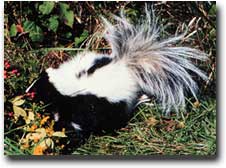Main Content
Article
Striped Skunk

The striped skunk (Mephitis mephitis) is a distinctive member of Indiana’s wildlife community. Their conspicuous black and white coloration warns of their best defense, the strong-smelling musk they spray to ward off threats. Skunks have poor eyesight and mostly hunt by nose and hearing, so it can be easy to startle one. However, often skunks give warning before spraying by stomping their feet and arching their back as a caution.
Similar species
General characteristics
- Striped skunks have a black body and legs, small, black head with a white blaze down the nose, and white stripes starting on the top of the head and running down the back. Striped skunks with an all-white back, or some white on the head and solid black backs also occur.
- The bushy tail is often black and white intermixed.
- Skunks have long claws, especially on the front feet, which they use to dig for worms, insects, and invertebrates in the ground and rotten logs.
- Skunks produce a strong musk to deter predators that they expel from anal glands.
- Skunks are generally solitary, and females may be aggressive toward males when pregnant or raising young. Skunks become more tolerant of each other during winter, and several skunks may be found in a warm nest during cold periods.
- Skunks are usually nocturnal but may be seen during the day looking for food.
Distribution and abundance
Striped skunks have the largest range of the five skunk species in the U.S. They exist in every state except Alaska and Hawaii. The striped skunk lives in every Indiana county. Skunks prosper in a variety of habitats including wetland, forest and agricultural edge. Striped skunks are also common in urban areas. Skunks become inactive during the coldest periods, but they do not hibernate and may be active year-round.
Reproduction
Skunks mate during late February or early March, with four to seven mouse-sized young born 62 days later in May. They may have multiple mates and males do not help raise young. Skunks use dens to give birth and raise young. They either dig their own or enlarge an existing den, such as a groundhog burrow. Skunks are weaned after two months and the young skunks follow their mother for the first few months before going off on their own in fall. Baby skunks begin producing their recognizable musk at 8 days old.
Food habits
Skunks are an opportunistic omnivore, eating just about any vegetable, animal or insect that it can get its paws on. However, much of their food consists of invertebrates, and they may make distinctive conical holes in a mowed yard to get at worms or grubs. Primary foods include
- Insects and invertebrates, including worms, grubs, bees and wasps
- Mice and other small mammals
- Birds and eggs
- Fruits, nuts and plants
- Snakes, frogs and lizards
Management and control
Being generalists, habitat management for skunks is not necessary. Keeping pesticide levels moderate can reduce the chance of incidental poisoning of skunks through the eating of infected mice and invertebrates. There is a regulated hunting and trapping season for skunks that avoids the breeding season when kits are young.
Resident landowners and tenants can trap a skunk that is causing damage on their own property without a permit from the DNR. The skunk must be euthanized or released within the county of capture on private property on which you have permission to release the skunk. In order to prevent the spread of disease, the DNR encourages homeowners to safely and humanely euthanize skunks, if possible. If you do not want to trap the skunk yourself, contact a licensed nuisance wild animal control operator.
Occasional skunk sightings around neighborhoods should not be cause for alarm. Skunks are generally not aggressive and will only spray if they feel cornered or attacked. Monitoring pets while outside, keeping cats indoors and dog on leashes are critical to preventing unwanted encounters with all wildlife, including striped skunks. Considerations to discourage skunks include:
- Turn on a radio to a talk station and leave it on overnight if you want to discourage a skunk that is living under your porch or hanging around your deck.
- Keep bird feeders and garbage cans in at night. Pick up fallen fruit from fruit trees. Don’t feed pets outside, or clean up uneaten pet food if pets are fed outdoors. Make sure compost is inaccessible.
- Keeping potential den sites closed can be helpful to discourage denning on your property. Block abandoned groundhog holes or fence the bottoms of decks or porches to prevent access by skunks.
- If you find a skunk trapped in a window well, place a rough board in the well that extends to the top and it will climb out on its own.
- If a skunk gets into the house, open a door and calmly allow it to exit. Don’t chase or excite the skunk. Keep pet doors secure at night to prevent wildlife like raccoons, skunks, or opossums from wandering in uninvited.
- Block any access points into sheds, garages, basements or attics so a skunk can’t find a warm place to sleep in buildings.
